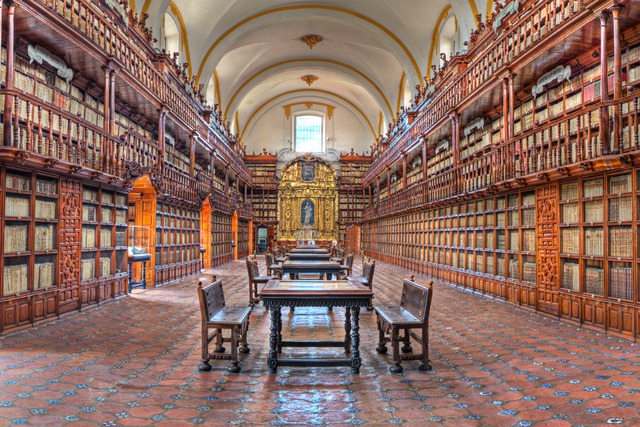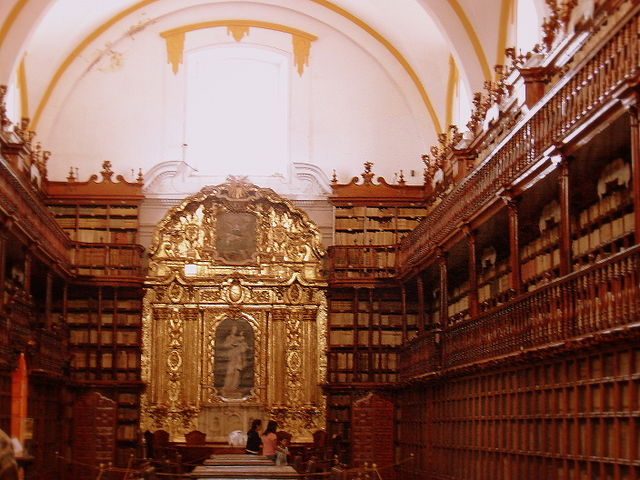The Palafoxiana Library, Mexico

Opened in 1646, the Biblioteca Palafoxiana in Puebla, Mexico, is sometimes described as the first library in the Americas.
UNESCO includes it on its Memory of the World Register, along with the epigraphic archives of Wat Pho, the King Ram Khamhaeng Inscription, and many other international precious cultural artefacts. The Biblioteca Palafoxiana was named after its founder Juan de Palafox y Mendoza, bishop of Puebla. Bishop Palafox valued reading, and considered that the books in his collection were his “jewels.” Apart from his native Spanish, he could read Latin, Greek, Hebrew, Chaldean, Sanskrit, and ancient local languages, including Mixtec and Totonac. Bishop Palafox admired the native peoples of Mexico, and even wrote a book entitled Virtues of the Indian. He also wrote a history of the conquest of Ming Dynasty China by the Manchus. He once stated:
He who succeeds without books is in an inconsolable darkness, on a mountain without company… in darkness without a guide.
He insisted that the books which he donated to the library be made available to the general public, so that “all sorts of people will be able to study as they wish.” The bishop also said:
[Books] are entertaining, useful, enjoyable, and soothing. If they are tiring, they can be set aside. If they are relaxing, they can be continued. They always teach in silence, they reprimand without hurting.

The building which houses the library was built in the 1700s, including a hall 43 meters long with bookshelves made of beautiful woods native to Mexico. Two earthquakes in 1999 damaged the library. The structure had already been weakened by the weight of the bookshelves as well as insect damage. The World Monuments Fund, a New York-based organization, helped to restore the library to its original beauty. As part of an ongoing preservation initiative, a digital catalog of the library collection was made available in 2010, highlighting its unique collection of early printed books. These books, often bound in goatskin, complement the elegant furnishings of the library.
Thailand and Mexico
Only in October, 2014 did Thailand and Mexico have their first meeting for consulting on political issues and other matters of common interest. The meeting was co-chaired by Khun Songsak Saicheua, Director General for American and South Pacific Affairs of the Ministry of Foreign Affairs of Thailand, and Mr. Alejandro Madrigal Becerra, Director General for Asia Pacific Affairs of the Ministry of Foreign Affairs of Mexico. It took place at the Ministry of Foreign Affairs of Mexico. Among other attendees was His Excellency Chirachai Punkrasin, the Ambassador of Thailand to Mexico, as well as representatives from Thailand International Cooperation Agency (TICA) and the Mexican Agency for International Development Cooperation (AMEXCID).
Among the subjects discussed was how to commemorate the 40th anniversary this year of the establishment of diplomatic relations between the two countries. They resolved to conclude agreements on promoting and protecting investments, tourism, and eliminating double taxation.
Thailand and Mexico have cooperated in the past, such as in 2010, when both offered assistance after the Haitian earthquake of 2010. In longer range plans, it is hoped that ASEAN countries can have closer cooperation with those in the Pacific Alliance (PA), such as Mexico. Currently, mutual trade is increasing between Thailand and Mexico, which makes Mexico Thailand’s second largest trade partner in Latin America.

Thoughts from Mexico’s minister of foreign affairs.
In 2011, Patricia Espinosa Cantellano, then Mexico’s Minister of Foreign Affairs, wrote “Mexico and Thailand: friends across the ocean,” a guest column in the Nation. Ms. Espinosa-Cantellano suggested that despite the distance which separates them, Thailand and Mexico have much in common. She noted:
Mexico and Thailand are economic focal points in their respective regions and in spite of the effects that the recent world financial crisis had on both countries they have continued to build on their trade exchanges. For example, in 2010 Thailand became Mexico’s 6th largest commercial partner in the Asia-Pacific region, the 18th in the world. In 2011 our trade registered at US$2.9 billion, a 36.6 per cent growth since 2009. The Mexican and Thai business communities have an exceptional opportunity to establish strategic links in automotive and auto parts, food, infrastructure and construction. I use this opportunity to invite Thai investors to profit from the advantages my country offers, given its strategic position as gateway to both North and Latin America through the wide network of free trade agreements with countries in the Americas and beyond.
Just as both nations are working to find solutions to the problems of climate change, there is also a shared interest in developing tourism as a key aspect of the economy. Ms. Espinosa-Cantellano observed: “According to food aficionados, Thai and Mexican cuisines are amongst the five richest and most varied in the world.”
(all images courtesy of Wikimedia Commons).

